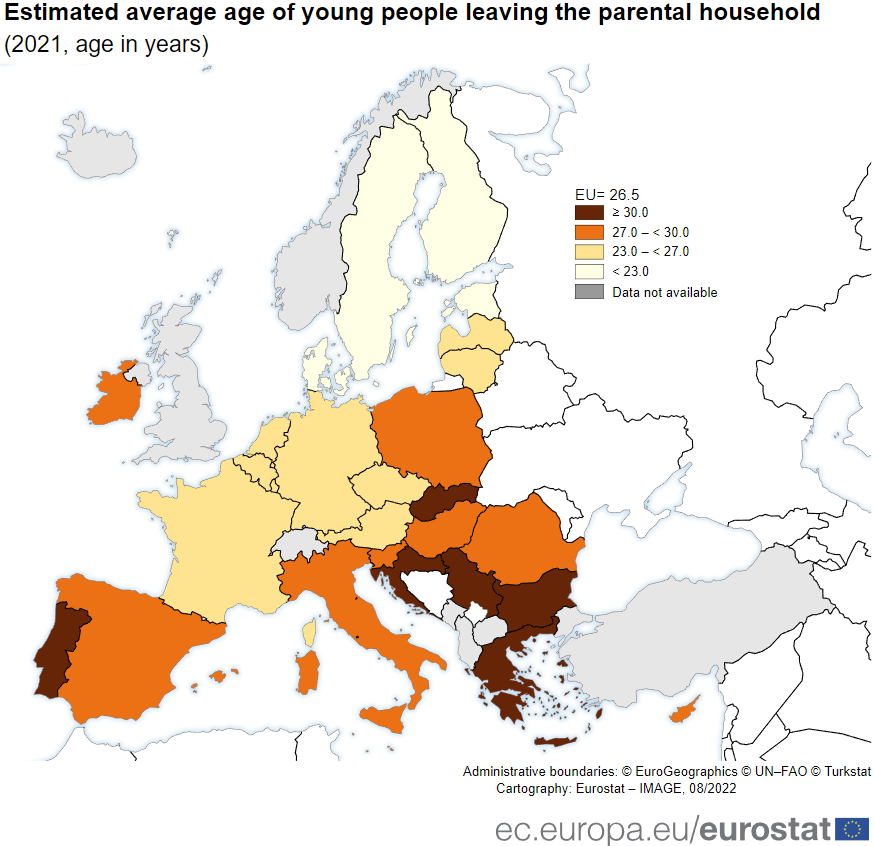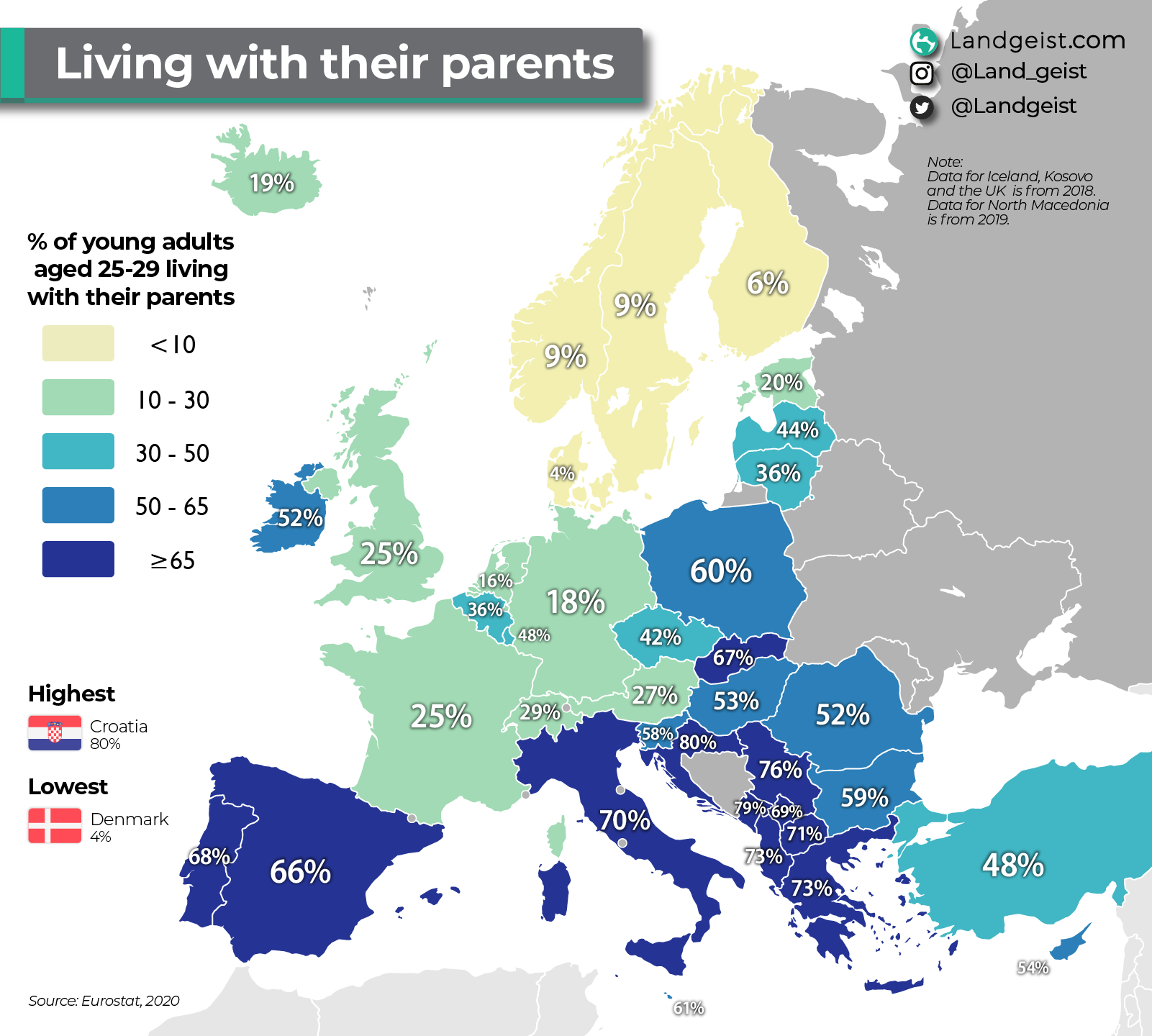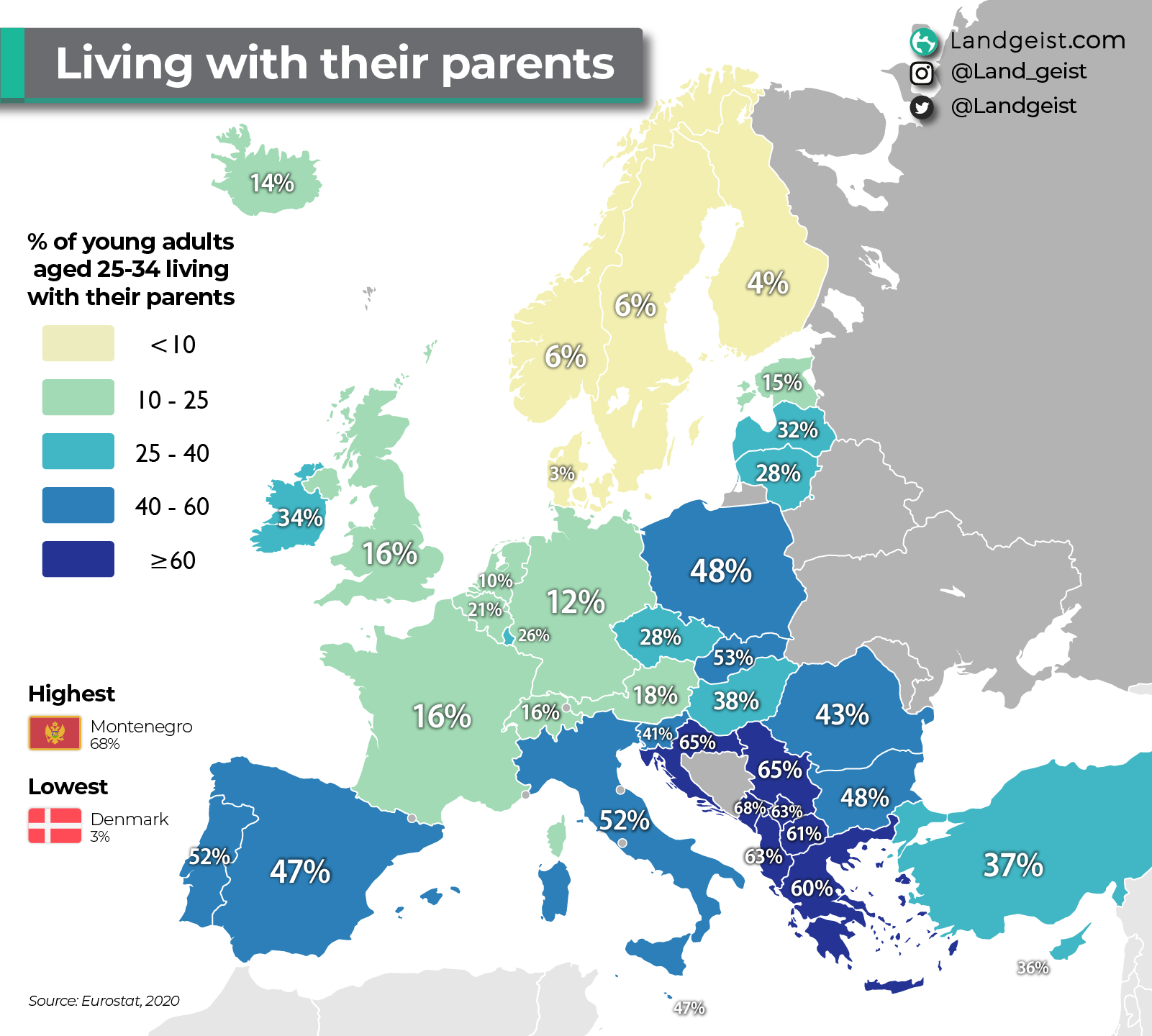Average Croat Moves Out of Family Home at 33, Only Portuguese Worse
September 4, 2022 - According to Eurostat, the average Croat moves out of their parents' home only at 33.3. Only in Portugal is the number even higher, with some 3 months difference.
As Poslovni reports, young people in Croatia, along with the Portuguese, leave their parents' "nest" the latest. They will leave the family home, on average, only at the age of 33.3. Only the Portuguese who live with their parents three months longer are worse, according to the Eurostat survey for 2021.
Unlike Croats, Portuguese, Slovaks, Greeks, and Bulgarians, countries where young people leave their parents' home on average only at 30 or older, young Swedes will leave at the age of 19. In Finland, on average, at 21.2, in Denmark at 21.3, and Estonia at 22.7.
Eurostat statistics show drastic differences between countries in leaving the family home among young people. Thus, in most countries of Western and Northern Europe, on average, young people leave their parents in their early or mid-20s. On the other hand, in southern and eastern countries, this average rises to the late 20s or early 30s.

Nikola Baketa, a research associate from the Institute for Social Research in Zagreb, states that there are several reasons why young Croats leave their parents' homes late, but the main ones are economic.
"There are several aspects. The first is employment. Young people are more likely to work on a fixed-term basis and are paid less, which affects the safety and security of work. In such a working relationship, it is difficult to get a loan, which is necessary for buying real estate", says Baketa, adding that the purchase of real estate is another problem that causes young people in Croatia to leave their parents’ homes only after 30.
"Real estate and rental prices in Croatia are high. In addition, the rent is irregular. In Croatia, there are no long-term rental policies or affordable city apartments that would make it easier for young people to become independent", he points out.
And the authorities do not seem to care, as demonstrated by the fact that since 2017, when the National Youth Program expired, they have not bothered to bring a new one. That would at least declaratively show how the state plans to ease the position of this very heterogeneous group.
The consequences are becoming apparent, as fewer and fewer people remain in Croatia, and it is the young who most often leave the country.
Interestingly, statistics show that men in the European Union leave the family home later than women. On average, they are 27.4 years old, and women are 25.5 years old. This trend is present in all countries, say European statisticians.
Baketa assumes that this is because women get married and leave their homes earlier. But as he points out, this is only an assumption.
For more, make sure to check out our Lifestyle section.
Croatia, the European Country with Most Young Adults Living With Their Parents
June 11, 2022 - With official Eurostat figures shown through a map designed by the Landgeist portal, it is shown that Croatia is the European country with the most young adults living with their parents.
Several factors could be attributed to the fact that Croatia ranks first among the countries with the highest percentage of young adults (25-29 years old) who still live with their parents. High rental costs, family businesses, or it could even be an attachment issue. The fact is that 80% of young adults in Croatia have not yet left the nest.
Although Croatia is the European country that stands out from the rest, the same trend can be highlighted in other countries of the Balkan region, such as Serbia (76%), Montenegro (79%), Albania (73%), Kosovo (69 %) or North Macedonia (71%).
Landgeist is a web portal that compiles and analyzes statistics from different countries and continents of the world, on a wide variety of topics, and designs maps that help to better understand the analysis and compare the numbers between different countries or regions more easily. Landgeist commented on his most recent map of the percentage of young adults living with their parents:
''Until what age young adults live with their parents can depend on a lot of factors. Culture, housing, the economy, and religion can all play an important role in that. For this map, we can straight away see that there is a very strong geographical pattern for this subject.'', analyzed Landgeist.
''The differences in numbers are enormous in Europe. While only a very tiny percentage of Danes between the ages of 25 and 29 live with their parents, the vast majority of people in the same age group in the Balkans live with their parents.'', added the portal.

''As we start looking at south and eastern Europe, we can see that the percentages are mostly over 50%. The highest percentages can be found in the Balkans. In most of the Balkan countries, 70% of young adults live with their parents. The number is the highest in Croatia, where 80% of young adults live with their parents.'', said Landgeist.
''The data for this map comes from Eurostat. The data also includes people that live with only one parent''. For this dataset, Landgeist thought it would be most interesting to look at the oldest age group of young adults. ''The source data contains numbers for the ages of 16 to 34. However, there is no data for specifically the 30 to 34 group, only 25 to 34. Which is too broad of an age group, according to Landgeist. Especially because there often is quite a bit of a difference between people in their late twenties and early thirties when it comes to job stability and income.'', they added.
''The data comes from a survey and is collected through interviews. So, the data is not based on where people are officially registered. In some countries, young people sometimes stay registered at their parent’s place. While in reality, they live elsewhere to study. This could skew the data for some countries. Fortunately, this dataset is based on where people actually live, instead of where they’re registered.'', Landgeist precise.

The web portal, using another source, also designed a map to analyze the situation of young adults between 25 and 34 years old, and in it Montenegro now leads, with 68%. However, Croatia remains in the top spot, this time tied second with Serbia, with a percentage of 65%.
For more, check out our lifestyle section.
56% of Young People in Croatia Didn't Access Pirated Material in Last Year
ZAGREB, 7 June 2022 - Fifty-six percent of persons aged 15-24 in Croatia did not access pirated content over the past year, while 28% did so intentionally, according to a European Union Intellectual Property Office survey.
Of those who did so intentionally, 77% accessed films, followed by TV series and shows (68%), music (48%), software (45%), live sport events (34%), videogames (41%), and e-books (21%).
Thirty-one percent of respondents in Croatia intentionally bought a fake product, most often clothes and accessories (12%), electronic devices (8%), shoes (7%), and cosmetics, perfumes, and personal care products (5%).
The survey shows that 52% of European respondents aged 15-24 bought at least one fake product online, while 33% accessed digital content from illegal sources.
Thirty-seven percent bought a fake product intentionally, while 21% used, played, downloaded or streamed content from illegal sources, the most in Greece (62%) and the least in the Czech Republic (24%).
The fake products young people in the EU buy intentionally are most often clothes and accessories (17%), shoes (14%), electronic devices (13%), and cosmetics, perfumes, and personal care products (12%).
As for digital content, 60% of respondents did not use, play, download or stream content from illegal sources over the last year.
The survey shows that 21% of young consumers consciously accessed pirated material in the last year, with 12% doing so by accident, while 7% don't know if they did.
Films accounted for the most pirated material (61%), followed by TV series (52%) and music (36%).
The survey shows that price and availability remain the main reasons for buying fake products and digital piracy, but peer influence and social influence are becoming increasingly important.
Cyber threats, fraud and environmental impact are among the most important factors deterring young people from fakes and piracy.
The survey was conducted on 7-28 February, covering 22,021 respondents in the EU-27.
For more, check out our lifestyle section.
Survey Shows Close to 50% of Young People Thinking About Leaving Croatia
ZAGREB, 9 Feb 2022 - Close to 50% of young Croatians occasionally or frequently think about leaving the country, and their stay depends on a number of factors, which is why it is necessary to focus on the value and cultural aspects of the problem, shows a survey on the motivation of young people to emigrate and start a family.
"When it comes to the likelihood of emigration, on a scale from 1 to 10, the average response was slightly above 4, which means that young people are divided over whether they want to emigrate, but almost half of them think about leaving occasionally or frequently," World Youth Alliance Croatia (WYAC) member Domagoj Dalbello said.
This shows that a significant number of young people are considering leaving the country. However, they do not leave on impulse, but rather consider the option for some time before leaving.
"Young people want 2.4 children on average, which is higher than the average number of children in Croatia. The reason why young people do not have more children is not exclusively because they do not want children, but that there are other discouraging circumstances", Dalbello said.
Socially more active want more children, less inclined to emigrate
58% of young people vote in parliamentary elections, 65% vote in presidential elections and 60% in local elections while 7-9% never vote, depending on the type of elections. At the same time, close to 90% of young people believe participation in elections should be higher, which means that they are aware of the importance of political participation.
The survey also shows that young people who vote more are less inclined to emigrate, making political apathy and lack of belief that one can change anything, one of the emigration factors.
15% of young people are active in civil society, while 7% are active in a political party.
Youths who are more active in civil society want to have several children on average, but want to do so later in life. They also have less of a desire to emigrate.
Those active in a religious community want to have several children while younger and have a lower desire to emigrate. This means that while membership of a political party may be related with lower intentions to emigrate, it is not related to the desired number of children.
The average likelihood of emigration of young people in the public sector is 3.1 and in the private sector 4, which poses a problem in terms of economy.
Slightly more than half of young people live with their parents and those who have moved out did so mostly at the age of 18 or 19, which coincides with the age when they go to college. The survey found that the later young people leave their parents' home, the later they start their own family.
The survey also shows that young people whose relatives live abroad are more likely to emigrate. Those who want to stay mention the country's beauty and the wish to live in their homeland, while those who are more likely to emigrate cite corruption and tourism.
Expert: Public policies focus on elderly
Marin Strmota, a lecturer at the Zagreb Faculty of Economics and former secretary for demography who unexpectedly resigned from that post at a news conference in 2018, warned that the share of young people in the total population was decreasing, hence their voices were less represented.
"If the share of older citizens is growing, public policies will naturally focus on the older population because it carries more votes," he said.
He noted that one should have clearer and more specific methods of attracting young people and that surveys should also be conducted locally because not all local government units have the same potential, problems and legacy.
Asked what he considered to be a bigger problem - the emigration of young people or the unwillingness to have children of those staying in the country, Strmota said that all negative processes were present - total and natural depopulation, generational depopulation and emigration depopulation.
An advisor at the Institute for Migration and Ethnic Studies, Sanja Klempić Bogadi, said that the state focuses too much on how to stimulate the return of those who have left instead of focusing on how to keep young people who are still in the country.
The WYAC survey covered 660 young people aged 18-30 with residence in Croatia and was conducted from 23 September to 1 December 2021 via social networks and e-mail.
For more, check out our lifestyle section.
Croatian Youth Leaving Country Because They Can't Leave Parental Home?
January the 19th, 2022 - There are many things responsible for the ongoing Croatian demographic crisis, from corruption to salaries to a bad economy, the list goes on and on. Croatian youth typically live with their parents for far longer than we see in most other European countries (with the exception of a few similar ones), could this be why they'd rather take their chances abroad?
As Poslovni Dnevnik/Marija Brnic writes, in the media presentation of the results of last year's damning census, the increase in housing units was singled out as a surprise, but this is not really unexpected.
In the previous census, the one from back in 2011, the same thing happened, the number of inhabitants of the country dropped, and the number of residential buildings increased. The difference is that the then smaller decline in population was accompanied by significantly higher growth in the number of real estate.
Specifically, in 2011, a total of 4.285 million inhabitants were counted in Croatia, ie 153 thousand less than ten years earlier, while in that interval the number of housing units increased by 370 thousand, to 2.247 million buildings.
The latest census recorded 3.889 million inhabitants and 2.350 million housing units.
However, the first data doesn't really give us a complete picture because, according to the president of the Real Estate Association, Dubravko Ranilovic, further processing has yet to reveal whether the reconstruction of the housing ''stock'' has finally begun and then we need to be given an accurate picture of the size, quality and purpose of these facilities. Reconstruction of the housing stock, he says, has been lacking so far.
In addition, the picture will be framed by data on the age structure of the population, as well as how many members of what we consider the Croatian youth have an apartment. So far, the population has been aging, and entering the EU acted as a "booster" for the emigration of Croatian youth.
The previous census from back in 2011 determined the average age of the country's residents to stand at about 42 years, which was three years more than in 2001. Now, of course, ''we'' will be even older, the only question is by how much.
92 percent of men and 84 percent of women under the age of 29 still live with their parents.
Dwellings are important in the overall picture, because one of the most cited problems in the emigration of Croatian youth was their inability to provide housing, independence and leave their parents' home. According to recently published Eurostat data, many households in Croatia are overcrowded, and the amount of Croatian youth still living with their parents is incredibly high.
In Croatia, 36 percent of the population lives in overcrowded homes, although 91 percent of people live in their own property, but these properties are too small, have too few rooms or too many household members. By comparison in the EU, the least overcrowded households are in Ireland, Malta and the Netherlands, where less than 5 percent of the population lives in overcrowded properties/homes.
When looking at the percentage of young people aged 16 to 29 living with their parents, Croatia is the EU record holder, because in those years, most Croatian youth still live with their parents. 92 percent of Croatian men and 84 percent of Croatian women still live ''at home'', while the EU average is 74 percent of men and 64 percent of women.
This matter will be made even clearer if it is known that apartments in Croatia make up only a quarter of the properties in the country, which might come as a surprise to some, so it is even clearer why young people find it much more difficult to stand on their own two feet and become independent.
Eurostat also found that from 2010 to the end of the third quarter of 2021, Croatian property prices, both for purchase and rent, were significantly below the EU average. Croatia is therefore among the countries with the lowest growth, and interestingly, the largest increase was in countries where Croatian youth tends to migrate, such as in Germany and Austria when it comes to selling prices, and Ireland when it comes to rent.
However, the prices themselves, although lower in Croatia than in Western European countries, are not crucial, according to Ranilovic, because it is noticeable that they fell in the areas from which the most people emigrated in recent years, and in those areas there were fewer transactions anyway. In addition, Ranilovic stated that as many as a quarter of Croatian property purchases, about 7,000 of them, were made by foreigners in Croatia last year.
For more, check out our dedicated politics section.
128,000 Workers Aged Under 35 Have Left Croatian Labour Market in Last 13 Years (Večernji List)
ZAGREB, 25 Oct 2021 - Some 128,000 workers aged under 35 have left the Croatian labour market in the past 13 years, so that now they account for only a third of the country's workforce, Večernji List newspaper wrote on Monday.
Under the new Labour Act, which is under preparation, workers will no longer be required to retire at 65 and will be allowed to continue working even after they meet the formal requirements for retirement, if they so wish and if there is work for them to do. Considering the present situation in the domestic labour market, many employers will turn to this age group for labour because the working age of employees has dramatically changed in the last decade and a half.
This summer the Croatian government boasted that Croatia had reached the second-highest employment rate in the last 30 years and surpassed pre-pandemic levels, which is true. However, the age structure of employees has substantially changed too, so that today only 481,000 employees are aged under 35, the newspaper said.
In 2008, the number of persons aged under 35 in the workforce was 609,000, which means that 128,000 people of the most productive working age have disappeared from the Croatian labour market in the past 13 years, which is equivalent to a city the size of Rijeka. These vacancies are increasingly being filled by older people, and considering the present trends, it can be expected that persons in their sixties and seventies will be in demand in the coming years.
The low birthrate and mass emigration are taking their toll and as a result Croatia now has 103,000 employees aged above 50 more than in 2008, namely 467,000. Over 100,000 of them will qualify for retirement in the next 10 years.
Croatia has imported nearly 100,000 foreign workers this year to meet the labour demand and they are included in the official statistics. Their number could be even higher in the years ahead. The government has proposed in talks with the social partners that the statutory retirement age of 65 be removed, which would make it possible for people to work as long as their health and labour market conditions permit, Večernji List said.
For more, make sure to check out our dedicated business section.
Youth Work in Flux Conference Held in Rijeka
June 23, 2021 - Youth Work in Flux Conference held in Rijeka mid-June saw scholars, researchers, scientists, and professionals discuss and present their work in the domain of youth work.
With more and more concern invested in youth in Croatia (both academically and professionally), June 15-17 saw Rijeka as the host of the conference titled „Youth work in flux: an academic point of view on youth work training and education“.
The conference was organized by the Institute for Social Research in Zagreb and partners: University of Rijeka and Slovenian University of Ljubljana held as part of the Erasmus + project Supporting Evidence-based Education of Youth Workers.
„Our aim is to strengthen the epistemic community of scholars and researchers in the domain of youth work, while instigating an academic debate on existing knowledge in the domain, defining further topics that need to be explored, and investigating the possibilities of co-creating the knowledge with actors from the community“, said the official website of the Institute for Social Research in Zagreb as the page was inviting „all interested scholars, researchers, and doctoral students to submit their abstracts and contribute to shedding light on this proliferating topic“.
Among such researchers, Dr. Marko Mustapić and Dino Vukušić from the Ivo Pilar Social Research Institute stood out. The two researchers presented results of the research „Youth Activism and Sport: Legacy of Dražen Petrović and ‘heritage in the making’“. Their ethnographic research investigated „Mi smo Cibona“ (We Are Cibona) association, centered around Cibona, a famous Zagreb basketball club, and how the youth in that association respond to the famous Croatian sportsman Dražen Petrović – how they perceive, interpret, or reinterpret Petrović's material and symbolic heritage and how they feel about basketball club today and what is the future of the association's activism.
The research was done as part of a project called CHIEF - Cultural Heritage and Identities of European Future done in the Horizont2020 frame.
As Ivo Pilar Social Research Institute informs, CHIEF started on May 1, 2018, with a budget of 4,58 million euros. The concept was split into 10 working packages challenging both in theory and in practice, but with a goal to conduct field research on the population 14-25 years of age, to see what we can perceive about Europe's identity in the future as these new generations develop into social and political participants.
With such conferences and various projects that aim to empower youth to stay in Croatia, it is evident that the importance of youth is finally recognized in the country. But, will that be enough to engage politicians to offer more things for the youth and stop the exodus of young Croatians from the country is yet to be revealed by future events.
When it comes to youth, learn more about what Croatia can offer to kids and families on our TC page.
For more about science in Croatia, follow TCN's dedicated page.
Young Croatians Rush to Study Mediterranean Agriculture
September 12, 2020 - Although this is a practically new study programme conducted by the University of Split, it is no surprise that Mediterranean agriculture is a study subject, and it filled the enrollment quota quite nicely in the first term, Slobodna Dalmacija reports.
The coronavirus crisis shook everything to its core, and many decided to return to their roots, literally. Healthy food, domestic products, gardening, winemaking and horticulture all climbed high on the list of priorities.
The perception of domestic agriculture as the pledge of a healthy economy has motivated many young people in Croatia to decide to enroll in this study programme, which has two courses. The first is viticulture and winemaking, and the second is horticulture, which includes olive growing, fruit growing, vegetable growing and floriculture.

Some of the classes will be held on the Institute for Adriatic Crops and Karst Reclamation / Copyright Romulić and Stojčić
A three-year study programme
Students of this study programme qualify for a bachelor's degree, ie engineer of Mediterranean agriculture (univ. bacc. ing. agr.).
"During the three academic years, which is as long as the study lasts, our students learn a lot of professional things, go into details, and it is especially attractive for them that they have a lot of practical classes in successful agricultural companies. Now we have attractive spaces in the centre of Split, where students will have a lecture room with a view of the Peristil, and some of the classes will be held on the Campus and the Institute for Adriatic Crops and Karst Reclamation," says doc. dr. sc. Leo Gracin, Head of the Study of Mediterranean Agriculture.

Viticulture and winemaking is a popular course among the youth at the Mediterranean Agriculture study programme / Copyright Romulić and Stojčić
"Connecting the economy and higher education through the model of teaching bases enables the contact of the economy with future young staff. Agricultural resources in Dalmatia are very potent for growing crops. Knowledge is one of the segments that is necessary for success in the demanding market of agricultural products. The University of Split and the Institute for Adriatic Crops and Karst Reclamation will change the situation with its engagement,“ claims Gracin.
He says that there are a lot of young islanders among the new freshmen, and half of those enrolled showed interest in focusing on winemaking and viticulture after the first year of the study programme, which is the same for everyone, while the rest of the freshmen are interested in other modules.
One of the people who are proud of holding a Mediterranean Agriculture diploma is Tonka Nincevic, who is an employee of the Institute for Adriatic Crops and Karst Reclamation.
Radiant faces
She described her experience from the faculty on the official Facebook page of this young university component. After graduating from high school, like most prospective students, she didn’t know which study programme exactly to enroll in.
"I decided to follow the old saying: when you do what you love, you don't work a single day in your life, in this case when you study what you love, it can't be difficult for you. This proved to be true later while attending the programme. I've always been interested in nature and the living world around us," said this employee of the Institute.
She immediately knew that Mediterranean agriculture was the best option for her when she saw photos of the first generation of students standing in the orchard, vineyard, laboratory, in the field, in the lecture hall ... She claims that the study programme provided her with many interesting lectures, practical work, fieldwork, and work in small groups.
"Whether you see yourself tomorrow as an independent entrepreneur, an employee of a company, institution, or as a scientist, this study programme provides you with the foundation for everything," concluded Nincevic.

Illustration from Pixabay
For the latest travel info, bookmark our main travel info article, which is updated daily.
Read the Croatian Travel Update in your language - now available in 24 languages
EU Youth Conference: Croatian Youth in Rural Areas Must be Prioritised
The Croatian demographic crisis is continuing to bite just as hard as it has ever done, with more and more Croatian youth abandoning the country and taking advantage of Croatia's EU membership for a better life and more economic stability in Western Europe, many feel the government has simple forgotten about them.
As Poslovni Dnevnik/Marta Duic writes on the 12th of March, 2020, in the Croatian capital of Zagreb at an EU conference, fifty experts discussed both opportunities and challenges.
On Wednesday, Zagreb hosted a two-day meeting where the topic of not only Croatian youth, but youth from across the bloc was discussed. The meeting of the leaders of the Youth Authorities' Administrations in Zagreb is the third in a series of such meetings of the presiding countries of Romania, Finland and Croatia, and a symbolic handover of the presidency to the German delegation was organised at the end of the meeting.
Within the main theme of the meeting, officials discussed the challenges facing today's generations of young people, including disillusioned Croatian youth, and the need to ensure equal life opportunities for all young people. Although the topic of youth in rural and remote areas is one of the priorities of Croatia's EU Council Presidency, the discussion also included other current issues.
Otherwise, the three-day conference entitled ''Youth Opportunities in Rural Areas - How to Ensure Rural Sustainability in EU Countries'' organised by the Ministry of Demography, Family, Youth and Social Policy brought together youth representatives from EU member states, delegates of the European Commission and the Council of the European Union, national and international youth organisations and researchers and scientists, as well as youth decision makers.
In her opening speech, Vesna Bedekovic, Minister for Demography, Family, Youth and Social Policy, stressed that Croatian youth and others across the EU living in rural and remote areas needed to be recognised as a priority of Croatia's EU Council Presidency because of the growing inequality between young people living in the countryside and those living in cities.
She added that the desire is to encourage young people to participate in democratic life, to increase their involvement in society and to ensure that as many young people as possible contribute to the formulation of youth policies. The conclusions of the conference will serve to shape the documents regarding future youth policies.
For more on Croatian youth and the current demographic crisis, follow our dedicated politics page.
Slavonski Brod Helps Young Families to Obtain Apartments in Special Way
Many Croatian landlords, typically those along the coast, are more than ready to kick paying tenants out when the tourist season comes knocking in order to make far more money renting their property in the short term to foreign holidaymakers. Owing to such practices, it can be much more difficult than it should be for young families to find a stable place to live. Slavonski Brod plans to make things easier.
Slavonski Brod, a city far from the coast, located in the continental part of Croatia, has decided to adopt a special way to help out its young residents, with a particular focus on young families who need a place to live.
As Novac writes on the 16th of September, 2019, Slavonski Brod has decided to help young families by giving them the possibility of renting land for a house or an apartment at a good price, more specifically of a mere one thousand kuna. And after ten years, they can buy that same plot of land or apartment.
In order to at least attempt to stop, or at best slow down the exodus of young people from Eastern Croatia, the City of Slavonski Brod is offering people the possibility of renting new apartments under the above-mentioned conditions, and the ten-year rent they will have paid will be deducted from the final price of the apartment.
''This is something that isn't present in our country except in Slavonski Brod,'' Mayor Mirko Duspara told HRT.
Local residents of Slavonski Brod are of course very pleased, and they say they are glad that the city realised that it was better to give families land at low prices, instead of merely seeing it stand there empty and unused.
''As you can see, the area is filling up. Everything will probably be filled up. It will be a young settlement, young families, lots of children, lots of young people,'' says Antun Lovrić from Slavonski Brod, who will soon celebrate moving in, while the signatories for new contracts are still awaiting construction.
Such help, they say, is more than welcome. Mihaela Ivković from Slavonski Brod explains her situation and just why this initiative is great for her:
''My husband and I were inquiring and looking for land. They were about 15 to 16 thousand euros per plot. That seemed great, it was very convenient to us,'' she stated.
This model will likely breathe some much needed life back into not only Slavonski Brod but the entire Eastern Croatian region, which continues to suffer from a brutal brain drain, with citizens leaving in their droves on a regular basis for better lives elsewhere.
Make sure to follow our dedicated lifestyle page for much more.


